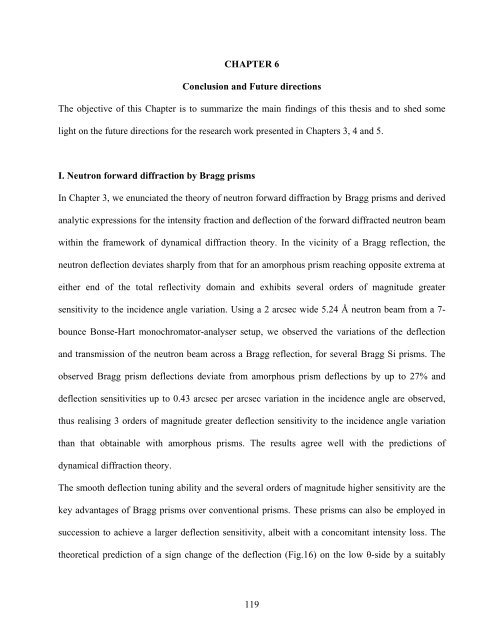PHYS01200804001 Sohrab Abbas - Homi Bhabha National Institute
PHYS01200804001 Sohrab Abbas - Homi Bhabha National Institute
PHYS01200804001 Sohrab Abbas - Homi Bhabha National Institute
Create successful ePaper yourself
Turn your PDF publications into a flip-book with our unique Google optimized e-Paper software.
CHAPTER 6<br />
Conclusion and Future directions<br />
The objective of this Chapter is to summarize the main findings of this thesis and to shed some<br />
light on the future directions for the research work presented in Chapters 3, 4 and 5.<br />
I. Neutron forward diffraction by Bragg prisms<br />
In Chapter 3, we enunciated the theory of neutron forward diffraction by Bragg prisms and derived<br />
analytic expressions for the intensity fraction and deflection of the forward diffracted neutron beam<br />
within the framework of dynamical diffraction theory. In the vicinity of a Bragg reflection, the<br />
neutron deflection deviates sharply from that for an amorphous prism reaching opposite extrema at<br />
either end of the total reflectivity domain and exhibits several orders of magnitude greater<br />
sensitivity to the incidence angle variation. Using a 2 arcsec wide 5.24 Å neutron beam from a 7-<br />
bounce Bonse-Hart monochromator-analyser setup, we observed the variations of the deflection<br />
and transmission of the neutron beam across a Bragg reflection, for several Bragg Si prisms. The<br />
observed Bragg prism deflections deviate from amorphous prism deflections by up to 27% and<br />
deflection sensitivities up to 0.43 arcsec per arcsec variation in the incidence angle are observed,<br />
thus realising 3 orders of magnitude greater deflection sensitivity to the incidence angle variation<br />
than that obtainable with amorphous prisms. The results agree well with the predictions of<br />
dynamical diffraction theory.<br />
The smooth deflection tuning ability and the several orders of magnitude higher sensitivity are the<br />
key advantages of Bragg prisms over conventional prisms. These prisms can also be employed in<br />
succession to achieve a larger deflection sensitivity, albeit with a concomitant intensity loss. The<br />
theoretical prediction of a sign change of the deflection (Fig.16) on the low θ-side by a suitably<br />
119
















